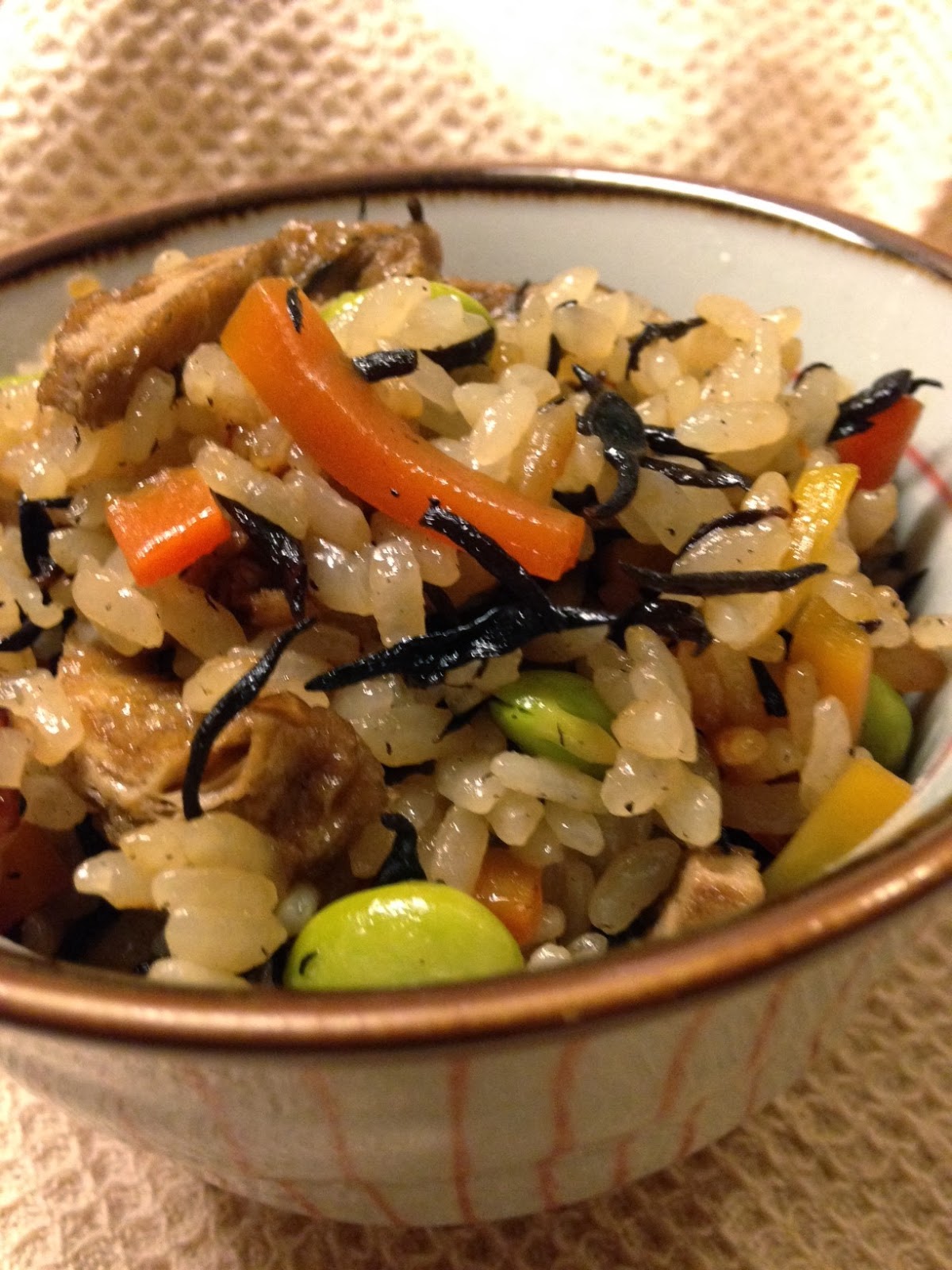Chikuzen ni - Simmered chicken with vegetables
 |
| Springtime root vegetables give chikuzen ni a delicious, earthy flavor. |
It's spring (officially)! The weather doesn't always agree, but the markets are showing signs of the changing seasons. Springtime root vegetables are particularly good. Bamboo shoots, carrots, taro, burdock and lotus root are in season from March and April. What better way to use all these wonderful ingredients than in a hot, homestyle bowl of chikuzen ni? Nothing fancy here, just straightforward simmering. The bulk of the labor is in chopping everything up, which is why most supermarkets sell bags of pre-cut vegetables for busy chikuzen lovers. When you do have time, it really is better to buy ingredients separately so that you can use the freshest stuff available.
When choosing ingredients for this dish, think about colors and textures. I love the decorative shape of sliced renkon and takenoko, they also add crunch to contrast with the creaminess of the satoimo, and the rubbery (in a good way!) texture of konnyaku. Break up the beige-ness of this dish with carrots, snow peas, and shiitake.
Serves 4
Time: 1 hr.
400 g chicken thighs
5 dried shiitake
250 g cake of konnyaku
1/2 takenoko, or 1 renkon... or both
1 gobo
1 carrot
8 small satoimo, peeled
1/2 cup snow peas
3/4 cup dashi
4 tbsp sugar
3 tbsp. sake, plus a little for soaking the chicken
2 tbsp. shoyu
2 tbsp. mirin
vegetable oil for frying
a little salt
Trim the excess fat and skin off the chicken. Keep the chicken pieces about 5 cm in size. Pour a little sake over them and let stand for about 5 minutes, then drain.
Put your shiitake in a small bowl and pour hot water over them to re-hydrate. Don't throw out that water! Keep it to add some oomph when you start simmering. When the shiitake have plumped up, cut off the stems and slice the caps in half (or quarters if they're particularly large), on the diagonal.
Boil the konnyaku for about a minute or two, then remove from water and let cool before ripping into bite-sized chunks. Better to tear than cut the konnyaku as it creates a textured surface that more easily absorbs flavors.
I used pre-cooked takenoko in this. I was told by my husband's aunt that you should always reboil takenoko using water reserved from washing rice, and a dried chili. It's supposed to bring out the flavor. Boil for about 10 minutes, then drain and slice. If using renkon, wash off the gunk and slice about 1 cm thick.
Scrape the outer layer of the gobo using the back of a knife, then cut on the diagonal, rolling the gobo slightly after every cut. This is called a "rolling wedge" cut, if you're interested. Cut it in 4 cm lengths and let it soak in some water for about 5 minutes. Peel and cut the carrot into wedges.
Heat some vegetable oil in a pot and then fry the gobo, renkon, satoimo, carrot, konnyaku, and takenoko until the surfaces have absorbed the oil. Add the chicken and shiitake. Keep frying until the chicken is no longer pink.
Now for the simmering process. First add the water reserved from re-hydrating the mushrooms, and the dashi. Let this come to the boil at medium heat, at which time, you can skim off any of scum that comes to the surface. Next, add the sugar and sake and give it a few minutes to cook with the stock. Then, for the shoyu. In my experience, it's best to add a little at a time, always tasting to make sure it's not too salty. If you dump all the shoyu in at once, you may find it's too salty for your liking, and at that point the only thing you can do is pour in water or bump up the stock and all the other seasonings... and then you're left with way too much liquid, which will take way too long to reduce, and leave everything mushy in the process. But, I digress.
Add the magic drop lid and let the liquid reduce to about half. Do this at about medium-low so that the satoimo doesn't start to break apart and make the stock murky. While this is reducing, trim the ends and the stringy bits off the snow peas. Let them boil for a couple of minutes in lightly salted water, drain and shock them in ice water to retain the vibrant, green color. Longer snow peas can be cut in half on an angle.
When the simmering liquid has reduced, add in the snow peas and the mirin. Turn up the heat and cook for say two minutes while gently mixing the ingredients to make sure the mirin really gets in there. Turn off the heat. Serve. Eat.


Comments
Post a Comment